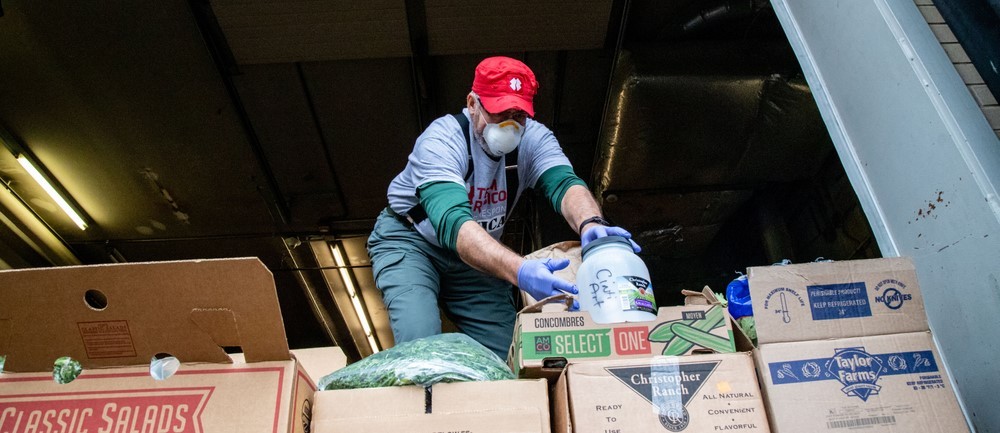Generosity During COVID-19: Recognizing and Encouraging The Gift of Giving When It’s Needed Most
It can be difficult to think about giving when there’s much that’s being taken away: the freedom to go wherever you feel, the community of a gathering, and even your income. Yet, as Christians, we’re called to be generous even in the most difficult of times, whether that’s with our time or our finances.
One gives freely, yet grows all the richer;
another withholds what he should give, and only suffers want.
Whoever brings blessing will be enriched,
and one who waters will himself be watered.
– Proverbs 11:24-25
The impact of the COVID-19 pandemic has been felt worldwide. Millions have fallen ill, people are filing for unemployment in record-breaking volumes, and communities are learning to connect through primarily-virtual platforms. But amid these hardships and challenges, acts of kindness and positivity are also spreading at new levels. Even in the most distressing times, humankind can show its good side in the most inspiring ways.
Churches, which have long used acts of service to spread the word of God, are also finding themselves having to do things much differently. Many churches have taken their ministry online, for example, and are having to consider new ways to engage their congregations digitally. This also means that generosity might look slightly different for the time being.
In this post, we’re shining a light on recent acts of generosity during this difficult time, plus providing tips for church leaders on how to encourage giving in their own communities.
5 Examples of Generosity Amid COVID-19
1. Healthcare workers volunteered to help flooded NY hospitals
New York City has been hit the hardest by COVID-19 than any other U.S. city to date, with hospitals becoming flooded with patients, resources dwindling, and local, frontline healthcare workers falling ill. The rest of the country didn’t take long to provide support. In March, over 76,000 healthcare professionals from across the U.S. left their homes to travel to New York and assist in the effort to treat patients.
2. Local restaurants are donating food to those in need
Aside from the virus itself, other risks are at play for families who can’t work and support themselves financially during stay-at-home orders. Across the country, we’ve seen countless acts of generosity to provide food to those who need it most. For example, in Tulsa, Oklahoma, a cafe and catering company, Elote, has been preparing two-week meal kits for local families. Churches and other organizations are also coming together to distribute food in their communities.
3. Germany took in COVID-19 patients from overwhelmed, neighboring countries
In March, Italy saw a massive influx of positive COVID-19 cases, as well as fatalities. Their resources were quickly overwhelmed and many parts of the country found itself in a dire state. Neighboring country Germany helped alleviate some of Italy’s (as well as France’s) strain, using its military Air Force planes to fly patients from the worst-hit region in Italy for treatment. Additionally, they offered over 120 ICU beds to Italy and France to keep up with the number of ill patients.
4. People are adopting and fostering pets from shelters who need a home, even if temporarily
A record number of fostered and adopted pets have been taken in by people throughout the country since the initial spread of COVID-19. A southern California shelter, for example, found that every single animal was given a home at one point in March. And while many people opted to foster vs. adopt initially, 60% to 70% of people who foster an animal keep them permanently.
5. Young, healthy individuals are running errands for those who are older and immuno-compromised
Since those who are above 60 years of age or have pre-existing health conditions have seen the highest rates of fatality due to COVID-19, many individuals are offering to run errands to pick up groceries and other household essentials for their neighbors who are wearier of leaving home. On the flip side, when those who’ve needed help have requested it, oftentimes multiple people have stepped up to the plate to help where they can. A woman in Michigan, for instance, asked for help finding alcohol wipes for her husband’s insulin injections, and many people immediately offered their support.
How to Inspire Generosity Within Your Church Community
The beauty of generosity is that you can provide it in whatever ways are possible, given your resources and circumstances. While the examples above include moments of above-and-beyond support, even simple acts of kindness and relief can have major impacts within your church community.
Take stock of your congregation’s most vulnerable members
Churches typically have support systems in place for members who need additional help, whether it be due to a family member passing, the loss of a job, or illness. It’s important that these members aren’t forgotten during this time and, if anything, are considered with extra care. While food banks and other organizational efforts to help your greater community are needed during this time, it’s also worth seeing what extra generosity can be afforded to those in your church who struggle even outside of this pandemic. Running errands for these members or even just checking in to lend an ear can go a long way.
Preach about the power of generosity during difficult times
When going through a difficult time, it’s easy to look inward and focus on our individual needs and suffering. Whether your church is live streaming sermons or beginning to congregate in person with social distancing practices, church leaders can use this opportunity to remind members about the grace and growth that occurs when we place more emphasis on what we can do for others. Lean on these Bible verses about the heart of generosity to guide your message.
Encourage those who can give to give
Given the downward trending economy right now, it’s unreasonable to expect that many of your members will be able to provide the same type of financial contributions as they have previously. Even those who haven’t lost income might be more eager to hold on to their finances for a rainy day. And this is completely understandable. As a church that supports your community, funds will be necessary to continue your good works. More than ever, being transparent with your congregation about how their financial generosity helps your town or city will make it more likely that members will give.
Remember to include those who can give their time
The fact of the matter is that not everyone is going to be able to give financially. But their time is just as valuable. Continue to organize efforts that your church community can rally around, whether that’s volunteering or working a phone chain that checks in on vulnerable members. Oftentimes, the greatest gift is knowing that someone took the time to do something for you, regardless of the cost.
Making The Most of Difficult Times
As a church leader, you’re working overtime right now to see your congregation through this extraordinary time, but you’re not alone. Churches, Christian thought leaders, and other spiritual organizations are leaning on each other now more than ever to be there for our communities effectively and lovingly. Pushpay is also here to help, with resources such as a checklist for pivoting your church to a digital strategy in times of crisis. Check out our blog and free ebooks to learn more about how other churches are responding to COVID-19 and engaging their congregations online.
Featured Content
You May Also Like

